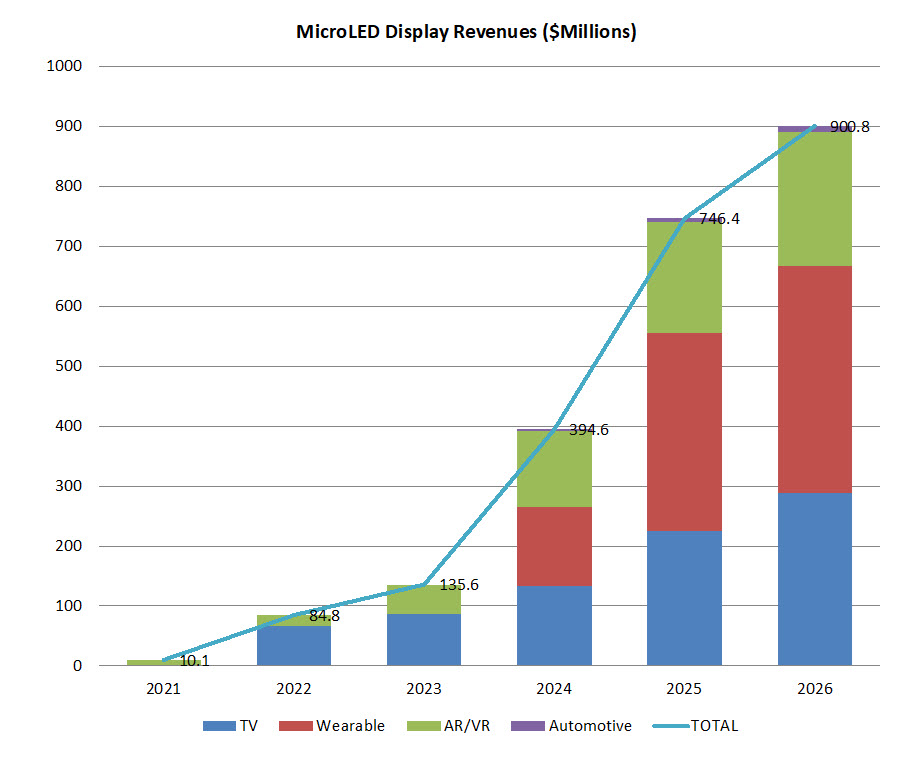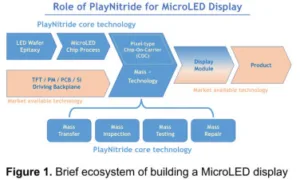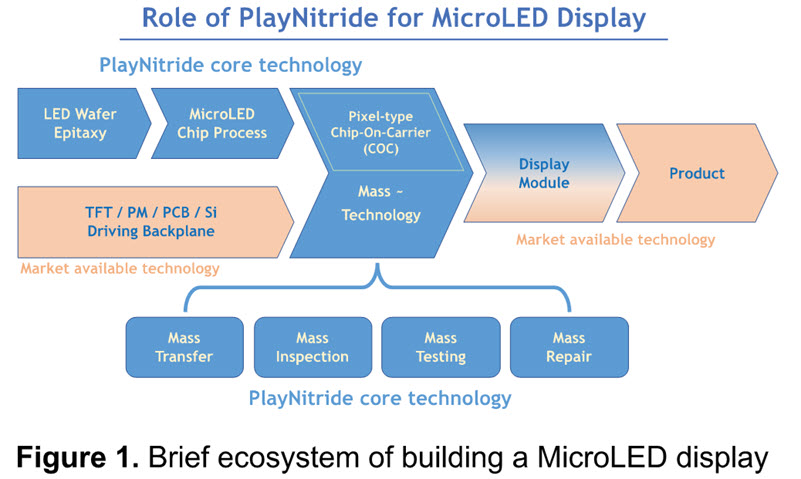Next Generation microLED displays were showcased and discussed at DisplayWeek 2022 through exhibitions, the Business Conference, symposiums and seminars.

MicroLED provides the best features of LCD and OLED display and has the potential to outperform both technologies in terms of color reproducibility, brightness, reliability and low power consumption. With the increased importance of the metaverse, there are greater requirements for next generation display products. Technology innovations are critical in enabling cost reductions and volume production.
Next Gen Products Requirements: Increasing
In a keynote speech, Joe O’Keeffe from Meta Reality lab outlined the technology requirements for AR and VR products in the metaverse era. AR glasses need a new generation of displays:
- Wide field of view with resolution to match reality
- Brightness to compete with a sunny day
- No artifacts for the user or neighbor (distortions, uniformity, rainbows, leakage)
- Manage vergence accommodation and eye movement
- Size, weight, style, eye-box with efficiency to enable all day use for all users
- Manufacturable (infrastructure available)
- See through
Looking at AR light sources:
For microOLED
- Pro – technology exists today
- Cons – pixel size, brightness and efficiency.
For microLED
- pros – pixel size and brightness,
- cons – efficiency, manufacturing capabilities and capacity
For microLED display, proof of concept projects are increasing but the supply chain doesn’t yet exist. He concluded by saying
“Without the right display technology, there is no Metaverse”.
(for more on O’Keeffe’s talk see this article What Displays Have to Do to Bring AR Superpowers
Manufacturing Capabilities: Improving
The microLED supply chain consists of the following steps: GaN epiwafer LED creation, processing of thin film LEDs, mass transfer of the chips to the display backplane & inspection and repair processes. High-speed transfer, assembly technologies, yield and defect management all need to improve and supply chains need to be established before large volume commercialization in consumer products can be done.
According to the symposium paper and presentation from Eric Virey’s, Yole Development:
“Progress in mass transfer over the last 5 years has been spectacular, to the point that, as of early 2022, most industry players no longer see it as a fundamental roadblock for ?LED. There is still a lot of work to get to mature, cost-effective, and robust processes fully ready for high volume manufacturing of consumer ?LED displays, but there is now a clearer runway”. His paper stated that “As of early 2022, stamp and laser-based tools are available from half a dozen of reputable suppliers”.
An invited paper (50.4) from Y.T. Liu, PlayNitride Display, stated that to realize high performance microLED displays, his firm has established a solution including LED wafer epitaxy, microLED chip process, massive process technology, including PixeLED display and SMAR Tech repair technology. His paper stated that mass repair technology is as important as the mass transfer technology. PlayNitride has also developed a different technology to transfer all three RGB colors; they are transferred to a temporary carrier and then get transferred to a backplane. They can make the spacing less than 2 micron, at the same time, the transfer yield is higher than 99.9% and cost is very low.
Application Market: Expanding
Companies such as PlayNitride, AUO and Innolux showed a variety of microLED display product demos at DisplayWeek 2022.
PlayNitride:
- 132-inch PixeLED Matrix tiling display banner with 2000nits brightness at the front of the booth.
- 38″ transparent (65%–70% transparency) display for automotive application
- 6″ 24:9 high resolution (2.5K) display for automotive application
- 58″ Passive Matrix display
- 5-inch QD microLED display with touch function
- 39″ circular and 1.56″ square display for smartwatch
- 0.49″ full-color FHD µ-PixeLED microLED micro-display 4,536 PPI, 50,000nits for AR glasses. (Awarded best new display technology @ DisplayWeek 2022)
 Play Nitride had an impressive display at Display Week – Image:Meko
Play Nitride had an impressive display at Display Week – Image:Meko
AUO
- Stretchable 141 PPI display (developed with PlayNitride).
- Rollable 14.6″ 2K (202 PPI) display with LTPS backplane
- 4″ circular display 454×454 (326 PPI)
- Stretchable 6.45″ display 900×450 (163 PPI)
- 3″ 2000-nits 1280×720 transparent (60% transparency) display
Nanosys/Glo
- 7-inch, 480×270 microLED microdisplay 50,000 nits, auto HUD application
Innolux
- 3” tiled QD microLED display with LTPS backplane 480x 180, 700 nits
The display integration of microLED can use heterogeneous or monolithic integration. In the heterogeneous type, makers use pick and place process to make the microLED arrays, and chips are transferred from an epiwafer or carriers to the display backplane (LTPS or Oxide TFT on a glass or flexible PI substrate). The monolithic integration process involves microLED array and backplane hybridization.
Technology Innovation: Continuing
- In an invited paper from AUO by C.L Wang on “High Resolution Stretchable microLED” the company said the RGB microLED display has been demonstrated to withstand mechanical strain during out-of-plane periodically deformation. In this display the high pixel density (>139-PPI) and high strain tolerance of circuits were achieved by utilizing the novel design of the island-bridge structure under a compact pixel arrangement.
- AUO’s W.L Chen’s invited paper on microLED tiling technology discussed the challenges and solutions of different seamless tiling technology. For backplane conducting technologies the paper mentioned several active-matrix designs, structures and suggestions. It also pointed out that production stability, yield performance, cost and side effect are also need to be considered.
- Chen from Tianma presented a paper on “High Performance microLED Transparent Display”. They have developed a 9.38″, transparent microLED display with 114ppi and 70% transmittance through an innovative pixel design layout and film layer stacking structure.
- Flemish from Lumileds presented an invited paper on “MicroLED Device Technology for Low Power Wearable Displays”. It discussed efficiencies for InGaN- R, G, B, and AlInGaP-R materials, as well as the dependence of performance on current density and emitter size. Lumileds blue, green, and red microLED devices are based on InGaN and AlInGaP materials systems.
- Paul Martin from Mojo Vision presented a paper on the firm’s contact lens-embedded microLED display. According to the paper Mojo Vision’s Contact Lens embedded AR/VR solution will fundamentally alter the way people receive and share information enabling information to be available during activities that require full use of the human body, a concept Mojo Vision calls “Invisible Computing.” (Mojo Vision Developing NanoLEDs)
- Zhu from Applied Materials presented an invited paper on “Progress on Key Innovations in Direct View microLED Manufacturing”. The company has demonstrated a microLED direct view display using single wavelength UV-A microLED and CD free Quantum Dot technology in an innovative pixel architecture (reducing and simplifying mass transfer and repair). (Applied Materials Overcomes Some Challenges in MicroLED for VR)
Product Commercialization: Progressing
According to Leo Liu’s presentation from DSCC at the Business Conference, in 2021 there are only small volumes of microLED displays in the forecast for TV and AR/VR. He identified three main factors as microLED manufacturing challenges.
- Lack of reliable, cost-effective manufacturing equipment
- Materials are also not ready for high volume production
- Need to overcome challenges at low costs for high volume manufacturing.
 MicroLED Revenue forecast – Source DSCC at SID/DSCC Business Conference
MicroLED Revenue forecast – Source DSCC at SID/DSCC Business Conference
Mathew Meiti from XDC presented at the Business Conference “mass transfer processes bring other kinds of semiconductors to the backplanes of advanced displays with a cost structure that can intercept the trajectory of mainstream consumer displays and, at the same time, set higher expectations for their picture quality, power efficiency, and integrated function”. XDC provides ultraminiature semiconductors for front planes and backplanes as well as mass transfer solutions for the display industry.
A presentation from Ian Jenks, SmartKem focused on Organic TFT. SmartKem and Nanosys have announced a joint venture agreement to collaborate on a new generation of low-cost solution printed microLED printed display using SmartKem OTFT and Nanosys microLED and quantum dot nanoLED technologies.
Dr. Tongtong Zhu from Prorotech presented about Gallium Nitride for microLED applications at the Business Conference. The company launched its first set of native InGaN-based R/G/B mono-colour microLED displays with ultrahigh brightness (2 million nits) in April 2022. (Porotech Unlocks A World First In Micro-LED Dynamic Pixel Tuning) According to the company its DynamicPixelTuning with its PoroGaN paves the way to manufacturable integratable monololithic full color RGB display. Porotech received the Best Prototype I-Zone award at DisplayWeek 2022 for its innovative process for achieving color tuning in one monolithic InGaN layer.
According Nikhil Balaram’s presentation from Mojo Vision at the SID/DSCC Business Conference,
“Micro-LEDs will make the dream of the metaverse a reality by offering tiny display systems with the super-high brightness and dynamic range needed for digital to blend perfectly with real, and the energy efficiency, and integration of compute and sensing, to enable the slim and light form factor needed for all-day all-use AR Glasses”.
MicroLED display technology is still evolving and making steady progress towards commercialization. Technology innovations are critical in enabling cost reduction and volume production. (SD)
Sweta Dash, President, Dash-Insights
Sweta Dash is the founding president of Dash-Insights, a market research and consulting company specializing in the display industry. For more information, contact [email protected] or visit www.dash-insights.com


